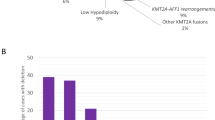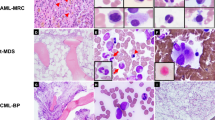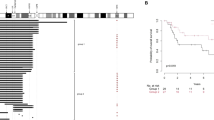Abstract
Within 285 adult acute lymphoblastic leukemias (ALL) included in the multicenter GIMEMA 0496 trial and prospectively studied by conventional cytogenetics, 18 cases (6%) with long arm deletion of chromosome 6 (6q) were identified. These cases were divided into: (i) del(6q) only (n = 6); (ii) del(6q) plus other numerical and/or structural abnormalities (n = 8); (iii) del(6q) and other ‘specific’ translocations (n = 4). The biologic and clinical features of the patients carrying this anomaly, as well as their outcome, were compared with those of 267 patients without del(6q). A T cell phenotype was more frequently associated with del(6q) cases in general (P = 0.001) and particularly with cases presenting del(6q) as the isolated abnormality (P = 0.0027). No significant difference with respect to multidrug resistance (MDR)/P glycoprotein expression was observed between the two groups of patients (21% vs 28% of MDR-positive cases, respectively). A BCR-ABL fusion transcript was less frequently detected in cases with del(6q) (11%) compared with those without the anomaly (29%). p15 and p16 deletions were identified by Southern blot analysis in 21% of cases with del(6q) and in 26% of cases without del(6q). In this latter group, a T cell phenotype was less frequently associated with p15 and/or p16 deletion than in the group carrying del(6q) (36% vs 100% of cases, P = 0.011). Overall, patients with ALL and del(6q) had a high complete remission (CR) rate (83%); however, they had a lower 18 month event-free survival (31% vs 41%) and a higher relapse rate (70% vs 37%, P = 0.02) compared with patients without del(6q). To date, this is the largest series of adult ALL cases reported with del(6q) homogeneously treated, which have also been prospectively studied for MDR expression and for the detection of known fusion genes. This anomaly, as an isolated change, identifies a subset of cases with hyperleukocytosis (median WBC count 52 × 109/l) and a strict correlation with a T cell phenotype. Overall, del(6q) seems to be associated with an unfavorable clinical outcome, although this finding will need to be confirmed by extended FISH analysis.
This is a preview of subscription content, access via your institution
Access options
Subscribe to this journal
Receive 12 print issues and online access
$259.00 per year
only $21.58 per issue
Buy this article
- Purchase on Springer Link
- Instant access to full article PDF
Prices may be subject to local taxes which are calculated during checkout

Similar content being viewed by others
References
Faderl S, Kantarjian HM, Talpaz M, Estrov Z . Clinical significance of cytogenetic abnormalities in adult acute lymphoblastic leukemia Blood 1998 91: 3995–4019
Hayashi Y, Raimondi SC, Look AT, Behm FG, Kitchingam GR, Pui CH, Rivera GK, Williams DL . Abnormalities of the long arm of chromosome 6 in childhood acute lymphoblastic leukemia Blood 1990 15: 1626–1630
Heerema NA, Sather HN, Sensel MG, Kraft P, Nachman JB, Steinherz PG, Lange BJ, Hutchison RS, Reaman GH, Trigg ME, Arthur DC, Gaynon PS, Uckun FM . Frequency and clinical significance of cytogenetic abnormalities in pediatric T-lineage acute lymphoblastic leukemia: a report from the Children's Cancer Group J Clin Oncol 1998 16: 1270–1278
Heerema NA, Sather HN, Sensel MG, Lee MK, Hutchison R, Lange BJ, Bostrom BC, Nachman JB, Steinherz PG, Gaynon PS, Ukun FM . Clinical significance of deletion of chromosome arm 6q in childhood acute lymphoblastic leukemia: a report from the Children's Cancer Group Leuk Lymphoma 2000 36: 467–478
The Group Francais de Cytogenetique Hematologique Cytogenetic. Cytogenetic abnormalities in adult acute lymphoblastic leukemia: correlations with hematologic findings and outcome. A collaborative study of the Group Français de Cytogenetique Hematologique Blood 1996 87: 3135–3142
Secker-Walker LM, Prentice HG, Durrant J, Richards S, Hall E, Harrison G on behalf of the MRC Adult Leukemia Working Party. Cytogenetics add independent prognostic information in adults with acute lymphoblastic leukaemia on MRC trial UKALL XA Br J Haematol 1997 96: 601–610
Wetzler M, Dodge R, Mrózek K, Carrol AJ, Tantravahi R, Block AMW, Pettenati MJ, Le Beau MM, Frankel SR, Stewart CC, Szatrowski TP, Schiffer CA, Richard AL, Bloomfield CD . Prospective karyotypic analysis in adult acute lymphoblastic leukemia: the Cancer and Leukemia Group B experience Blood 1999 93: 3983–3993
Todeschini G, Tecchio C, Meneghini V, Pizzolo G, Veneri D, Zanotti R, Riccetti MM, Solero P, April F, Perona G . Estimated 6-year event-free survival of 55% in 60 consecutive adult acute lymphoblastic leukemia patients treated with an intensive phase II protocol based on high induction dose of daunorubicin Leukemia 1998 12: 144–149
Bennett JM, Catovsky D, Daniel M-T, Flandrin G, Galton DAG, Gralnick HR, Sultan C . Proposal for the classification of the acute leukaemias: French–American–British (FAB) Co-Operative Group Br J Haematol 1976 33: 451–458
European Group for the Immunological Characterization of Leukemias (EGIL) Bené MC, Castoldi GL, Knapp W, Ludwig WD, Matutes E, Orfao A, Vant'Veer MB . Proposal for the immunological classification of acute leukemias Leukemia 1995 9: 1783–1786
Mitelman F . ISCN (1995) An International System for Human Cytogenetic Nomenclature S Karger: Basel, 1995
Hebert J, Cayuela JM, Berkeley J, Sigaux F . Candidate tumor-suppressor genes MTS1 (p16INK4A) and MTS2 (p15INK4B) display frequent homozygous deletions in primary cells from T- but not from B-cell lineage acute lymphoblastic leukemias Blood 1994 84: 4038–4044
Fizzotti M, Cimino G, Pisegna S, Alimena G, Quartarone C, Mandelli F, Pelicci PG, Lo Coco F . Detection of homozygous deletions of cyclin-dependent kinase 4 inhibitor (p16) gene in acute lymphoblastic leukemia and association with adverse prognostic features Blood 1995 85: 2685–2690
Chomczynsky P, Sacchi N . Single-step method of RNA isolation by acid guanidium thiocyanate–phenol–chloroform extraction Anal Biochem 1987 162: 156–159
Pallisgaard N, Hokland P, Riishoj DC, Pedersen B, Jorgensen P . Multiplex reverse trancription-polymerase chain reaction for simultaneous screening of 29 translocations and chromosomal aberrations in acute leukaemia Blood 1998 92: 574–588
Leith CP, Chen IM, Kopecky KJ, Appelbaum FR, Head DR, Godwin JE, Weick JK, Willman CL . Correlation of multidrug resistence (MDR1) protein expression with functional dye/drug efflux in acute myeloid leukemia by multiparameter flow cytometry: identification of discordant MDR−/efflux+ and MDR+/efflux− cases Blood 1995 86: 2329–2342
Merup M, Moreno TC, Heyman M, Rönnberg K, Grandér D, Detloffson R, Rasool O, Liu Y, Söderhäll S, Juliusson G, Gahrton G, Einhorn S . 6q deletions in acute lymphoblastic leukemia and non-Hodgkin's lymphomas Blood 1998 91: 3397–3400
Jackson A, Panayiotidis P, Foroni L . The human homologue of the Drosophila tailless gene (TLX) characterization and mapping to a region of common deletions in human leukemia on chromosome 6q21 Genomics 1998 15: 34–43
Jackson A, Carrara P, Duke V, Sinclair P, Papaioannou M, Harrison CJ, Foroni L . Deletion of 6q16-q21 in human lymphoid malignancies: a mapping and deletions analysis Cancer Res 2000 1: 2775–2779
Zhang Y, Matthiesen P, Harder S, Siebert R, Castoldi GL, Calasanz MJ, Wong KT, Rosenwald A, Ott G, Atkin NB, Schlegelberger B . A 3-cM commonly deleted region in 6q21 in leukemias and lymphomas delineated by fluorescence in situ hybridization Genes Chromosomes Cancer 2000 27: 52–58
Walters R, Kantarjian HM, Keating MJ, Estey EH, Trujillo J, Corl A, McCredie KB, Freireich EJ . The importance of cytogenetic studies in adult acute lymphoblastic leukemia Am J Med 1990 89: 579–587
Acknowledgements
Work supported by Istituto Superiore di Sanità, Italy–USA program on ‘Therapy of Tumors’, Rome; Associazione Italiana per la Ricerca sul Cancro (AIRC) Milan, legge 27 dicembre 1997, No. 449, Associazione Italiana contro le Leucemie sezione di Roma (ROMAIL), Italy; MURST fondi 60%. CM is supported by AIRC and AIL. We thank Dr S Raimondi for useful advice and comments.
Author information
Authors and Affiliations
Rights and permissions
About this article
Cite this article
Mancini, M., Vegna, M., Castoldi, G. et al. Partial deletions of long arm of chromosome 6: biologic and clinical implications in adult acute lymphoblastic leukemia. Leukemia 16, 2055–2061 (2002). https://doi.org/10.1038/sj.leu.2402640
Received:
Accepted:
Published:
Issue Date:
DOI: https://doi.org/10.1038/sj.leu.2402640
Keywords
This article is cited by
-
Evaluation of Cytogenetic Abnormalities in Patients with Acute Lymphoblastic Leukemia
Indian Journal of Hematology and Blood Transfusion (2019)
-
Molecular and cytogenetic changes in multi-drug resistant cancer cells and their influence on new compounds testing
Cancer Chemotherapy and Pharmacology (2013)
-
An unusual case of smoldering AML with prolonged indolent clinical course and spontaneous remission in the terminal phase
Medical Oncology (2009)
-
Loss of heterozygosity on chromosome 6q14–q24 is associated with poor outcome in children and adolescents with T-cell lymphoblastic lymphoma
Leukemia (2006)



